八大时态语法总结
初中英语语法总结8种时态
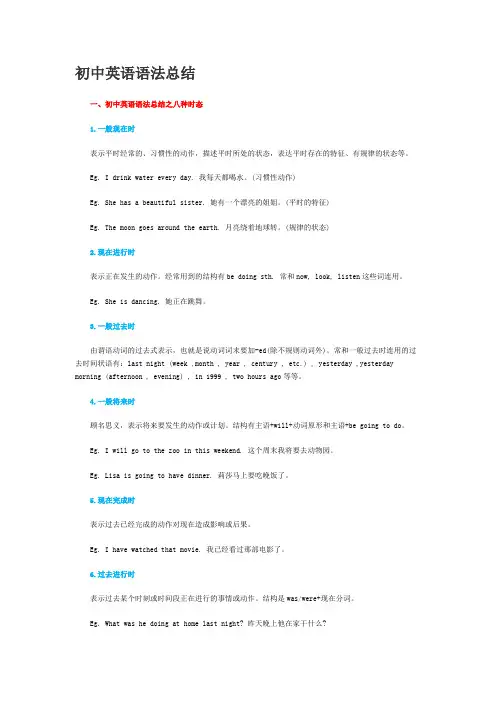
初中英语语法总结一、初中英语语法总结之八种时态1.一般现在时表示平时经常的、习惯性的动作,描述平时所处的状态,表达平时存在的特征、有规律的状态等。
Eg. I drink water every day. 我每天都喝水。
(习惯性动作)Eg. She has a beautiful sister. 她有一个漂亮的姐姐。
(平时的特征)Eg. The moon goes around the earth. 月亮绕着地球转。
(规律的状态)2.现在进行时表示正在发生的动作。
经常用到的结构有be doing sth. 常和now, look, listen这些词连用。
Eg. She is dancing. 她正在跳舞。
3.一般过去时由谓语动词的过去式表示,也就是说动词词末要加-ed(除不规则动词外)。
常和一般过去时连用的过去时间状语有:last night (week ,month , year , century , etc.) , yesterday ,yesterday morning (afternoon , evening) , in 1999 , two hours ago等等。
4.一般将来时顾名思义,表示将来要发生的动作或计划。
结构有主语+will+动词原形和主语+be going to do。
Eg. I will go to the zoo in this weekend. 这个周末我将要去动物园。
Eg. Lisa is going to have dinner. 莉莎马上要吃晚饭了。
5.现在完成时表示过去已经完成的动作对现在造成影响或后果。
Eg. I have watched that movie. 我已经看过那部电影了。
6.过去进行时表示过去某个时刻或时间段正在进行的事情或动作。
结构是was/were+现在分词。
Eg. What was he doing at home last night? 昨天晚上他在家干什么?7.过去将来时表示过去的某时以后将要发生的动作。
八种时态归纳总结
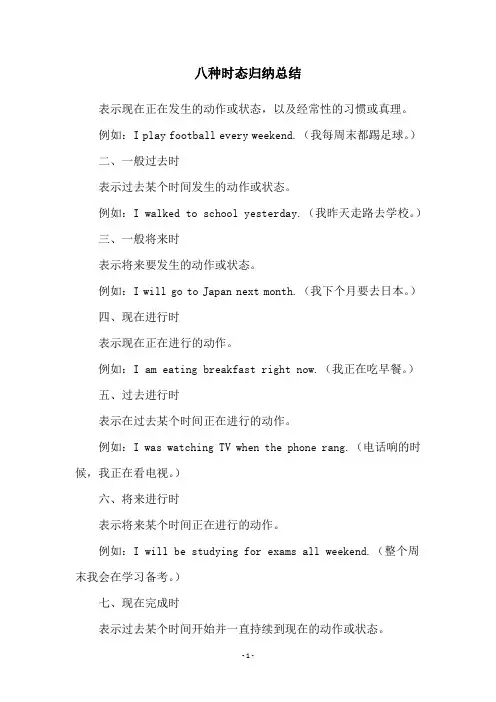
八种时态归纳总结
表示现在正在发生的动作或状态,以及经常性的习惯或真理。
例如:I play football every weekend.(我每周末都踢足球。
)
二、一般过去时
表示过去某个时间发生的动作或状态。
例如:I walked to school yesterday.(我昨天走路去学校。
)
三、一般将来时
表示将来要发生的动作或状态。
例如:I will go to Japan next month.(我下个月要去日本。
)
四、现在进行时
表示现在正在进行的动作。
例如:I am eating breakfast right now.(我正在吃早餐。
)
五、过去进行时
表示在过去某个时间正在进行的动作。
例如:I was watching TV when the phone rang.(电话响的时候,我正在看电视。
)
六、将来进行时
表示将来某个时间正在进行的动作。
例如:I will be studying for exams all weekend.(整个周末我会在学习备考。
)
七、现在完成时
表示过去某个时间开始并一直持续到现在的动作或状态。
例如:I have lived in this city for 5 years.(我在这个城市已经住了5年。
)
八、过去完成时
表示过去某个时间已经完成的动作。
例如:I had finished my homework by the time my friends arrived.(我的朋友到达时,我已经完成了作业。
英语八大时态总结
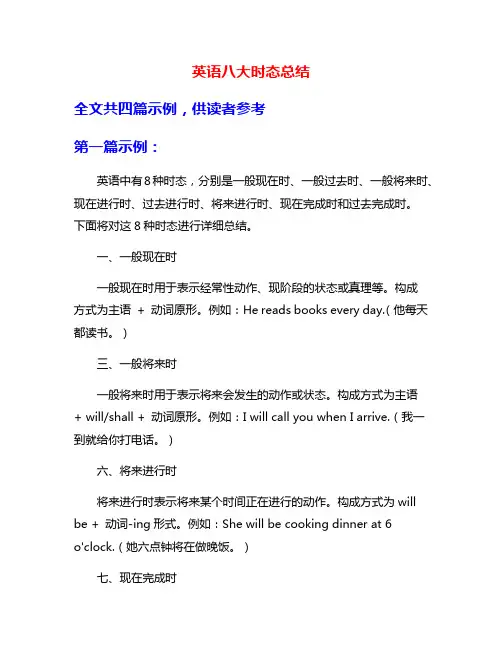
英语八大时态总结全文共四篇示例,供读者参考第一篇示例:英语中有8种时态,分别是一般现在时、一般过去时、一般将来时、现在进行时、过去进行时、将来进行时、现在完成时和过去完成时。
下面将对这8种时态进行详细总结。
一、一般现在时一般现在时用于表示经常性动作、现阶段的状态或真理等。
构成方式为主语+ 动词原形。
例如:He reads books every day.(他每天都读书。
)三、一般将来时一般将来时用于表示将来会发生的动作或状态。
构成方式为主语+ will/shall + 动词原形。
例如:I will call you when I arrive.(我一到就给你打电话。
)六、将来进行时将来进行时表示将来某个时间正在进行的动作。
构成方式为will be + 动词-ing形式。
例如:She will be cooking dinner at 6o'clock.(她六点钟将在做晚饭。
)七、现在完成时现在完成时用于表示过去某个时间开始的动作一直持续到现在,并可能继续发生。
构成方式为主语+ have/has + 过去分词。
例如:He has lived here for 5 years.(他在这里住了5年了。
)总结:1. 一般现在时表示经常性动作、现阶段的状态或真理。
2. 一般过去时表示过去某个时间发生的动作或状态。
3. 一般将来时表示将来会发生的动作或状态。
4. 现在进行时表示现在进行的动作或状态。
5. 过去进行时表示过去某个时间正在进行的动作。
6. 将来进行时表示将来某个时间将会进行的动作。
7. 现在完成时表示过去某个时间开始的动作一直持续到现在。
8. 过去完成时表示过去某个时间之前发生的动作。
掌握这8种时态的用法及构成方式对于学习英语语法和提高英语水平非常重要。
希望以上总结对您有所帮助。
第二篇示例:英语八大时态是学习英语语法非常重要的内容之一,掌握好各种时态的用法可以帮助我们更准确地表达自己的意思。
八大时态讲解

一般将来时的注意点:
be going to 与 will /shall区别: be going to 指当前的、已计划过或思考过的意图 和打算;
如:I am going to listen to music. (我打算听音乐 )
will /shall 表示未事先思考或为计划过的意图 如:It will be Christmas soon .(很快就圣诞节了 )
3.一般将来时态(The Simple Future Tense)
概念:表示将来某个时间要发生的动作或存
在的状态
谓语动词形式
:12..
will/shall+do am/is/are going
to+do
3. am/is/are + doing
常用时间状语 :
tomorrow, in three days,this…,
• 将来完成时: We will have had our exam by September 20.
• 过去将来完成时: He told them he would have finished by 9 o’clock.
英语的动词时态(完成进行)
• 现在完成进行时: Obviously she’s been crying. It has been snowing all night. The ground is covered with thick snow.
• 一般将来时: We will have a test next month. He is going to buy her some flowers.
• 一般过去将来时: He was sixty-eight. In two years he would be seventy. I knew you would agree.
英语八大时态总结
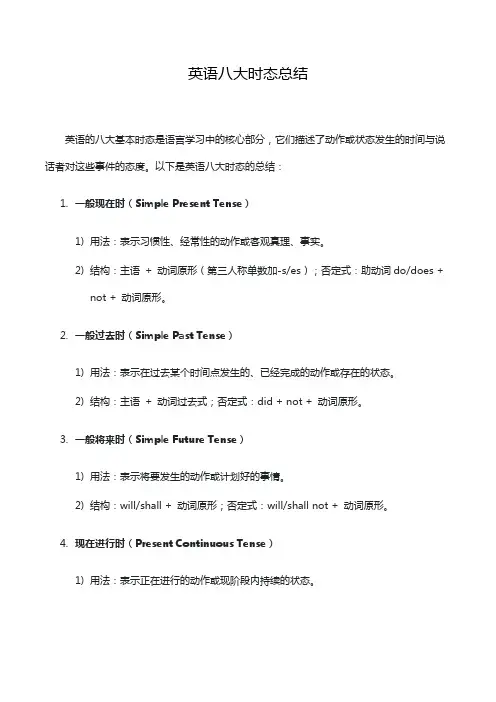
英语八大时态总结英语的八大基本时态是语言学习中的核心部分,它们描述了动作或状态发生的时间与说话者对这些事件的态度。
以下是英语八大时态的总结:1.一般现在时(Simple Present Tense)1)用法:表示习惯性、经常性的动作或客观真理、事实。
2)结构:主语+ 动词原形(第三人称单数加-s/es);否定式:助动词do/does +not + 动词原形。
2.一般过去时(Simple Past Tense)1)用法:表示在过去某个时间点发生的、已经完成的动作或存在的状态。
2)结构:主语+ 动词过去式;否定式:did + not + 动词原形。
3.一般将来时(Simple Future Tense)1)用法:表示将要发生的动作或计划好的事情。
2)结构:will/shall + 动词原形;否定式:will/shall not + 动词原形。
4.现在进行时(Present Continuous Tense)1)用法:表示正在进行的动作或现阶段内持续的状态。
2)结构:am/is/are + 动词-ing形式;否定式:am/is/are + not + 动词-ing形式。
5.过去进行时(Past Continuous Tense)1)用法:表示过去某段时间内正在进行的动作或背景。
2)结构:was/were + 动词-ing形式;否定式:was/were + not + 动词-ing形式。
6.现在完成时(Present Perfect Tense)1)用法:表示过去发生的动作对现在的影响或从过去一直持续到现在的情况。
2)结构:have/has + 过去分词;否定式:have/has + not + 过去分词。
7.过去完成时(Past Perfect Tense)1)用法:表示在过去的某一时间之前已经完成的动作。
2)结构:had + 过去分词;否定式:had + not + 过去分词。
8.将来完成时(Future Perfect Tense)1)用法:表示在将来某一时刻之前将要完成的动作。
英语八大时态总结表
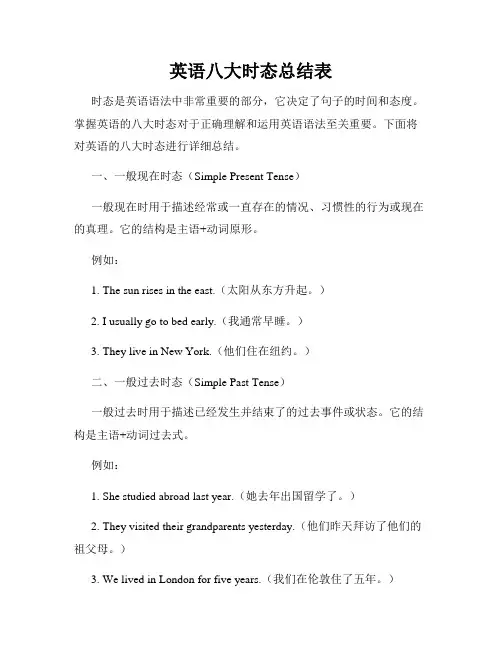
英语八大时态总结表时态是英语语法中非常重要的部分,它决定了句子的时间和态度。
掌握英语的八大时态对于正确理解和运用英语语法至关重要。
下面将对英语的八大时态进行详细总结。
一、一般现在时态(Simple Present Tense)一般现在时用于描述经常或一直存在的情况、习惯性的行为或现在的真理。
它的结构是主语+动词原形。
例如:1. The sun rises in the east.(太阳从东方升起。
)2. I usually go to bed early.(我通常早睡。
)3. They live in New York.(他们住在纽约。
)二、一般过去时态(Simple Past Tense)一般过去时用于描述已经发生并结束了的过去事件或状态。
它的结构是主语+动词过去式。
例如:1. She studied abroad last year.(她去年出国留学了。
)2. They visited their grandparents yesterday.(他们昨天拜访了他们的祖父母。
)3. We lived in London for five years.(我们在伦敦住了五年。
)三、一般将来时态(Simple Future Tense)一般将来时用于描述将来会发生的事件或状态。
它的结构是主语+will+动词原形。
例如:1. I will meet my friends tomorrow.(我明天会见我的朋友。
)2. They will travel to Japan next month.(他们下个月会去日本旅行。
)3. She will study hard for her exams.(她将为考试努力学习。
)四、现在进行时态(Present Continuous Tense)现在进行时用于描述正在进行的动作或当前的情况。
它的结构是主语+am/is/are+动词-ing形式。
例如:1. She is watching TV at the moment.(她此刻正在看电视。
英语八大时态总结表格
英语八大时态总结表格时态是英语语法中的重要部分,掌握好各个时态的用法和变化规则,可以帮助我们清晰地表达不同的时间和状态。
下面是对英语八大基本时态的总结,包括使用形式、用法和常见的时间状语等。
一、一般现在时 (Simple Present Tense)形式:主语 + 动词原形(第三人称单数需加-s或-es)用法:1. 表示经常性的动作或习惯。
例句:She often walks her dog in the park.2. 表示客观事实、科学真理或普遍规律。
例句:Water boils at 100 degrees Celsius.3. 表示感觉、状态或永久性的情况。
例句:He loves ice cream. They live in New York.二、一般过去时 (Simple Past Tense)形式:主语 + 动词过去式用法:1. 表示过去某个具体时间发生的动作或事件。
例句:She went to Paris last summer.2. 表示过去经常发生的动作或习惯。
例句:He always ate breakfast at home.3. 表示过去的状态或情况,通常和表示时间的副词连用。
例句:It rained heavily yesterday.三、一般将来时 (Simple Future Tense)形式:主语 + will/shall + 动词原形用法:1. 表示将来的意愿、打算或决定。
例句:I will help you with your homework.2. 表示将来发生的动作或事件,没有具体的时间。
例句:They will arrive tomorrow.3. 表示预测、推测或假设。
例句:It will probably rain this evening.四、现在进行时 (Present Continuous Tense)形式:主语 + am/is/are + 现在分词用法:1. 表示正在进行或发生的动作。
初中英语语法八大时态总结完整版
初中英语语法八大时态总结完整版一、一般现在时1.定义:表示经常性或习惯性的动作、状态或真理。
2.结构:主语+动词原形(+其他成分)。
3.例句:(1) I go to school every day.(2) He often plays basketball after school.(3) Water boils at 100 degrees Celsius.二、一般过去时1.定义:表示过去一些时间发生的动作或存在的状态。
2.结构:主语+动词的过去式(+其他成分)。
3.例句:(1) They visited their grandparents last weekend.(2) She lived in Beijing when she was young.(3) We studied English in middle school.三、一般将来时1.定义:表示将来一些时间将要发生的动作或存在的状态。
2. 结构:主语 + will + 动词原形(+ 其他成分)。
3.例句:(1) I will go to the park tomorrow.(3) We will have a party next week.四、现在进行时1.定义:表示现在正在进行的动作。
2. 结构:主语 + am/is/are + 动词-ing(+ 其他成分)。
3.例句:(1) She is reading a book right now.(2) They are playing soccer in the park.(3) We are having dinner at the moment.五、过去进行时1.定义:表示过去一些时间正在进行的动作。
2. 结构:主语 + was/were + 动词-ing(+ 其他成分)。
3.例句:(1) He was watching TV at 8 o'clock last night.(2) They were traveling in Europe during summer vacation.(3) We were studying when the phone rang.六、将来进行时1.定义:表示将来一些时间正在进行的动作。
八种时态归纳总结
八种时态归纳总结一、一般现在时1、表示经常性或习惯性的动作或存在的状态,常和表示频度的时间状语连用,如:always, often, sometimes, seldom, usually, every day/week/year, on Sundays等。
2、表示客观存在,普遍真理,科学事实,格言,公认的看法时,如:The earth moves around the sun.二、现在进行时1、表示正在进行的动作,常和表示现在的时间状语连用,如:now, at the moment, still, just等。
2、表示临时的或偶然的动作,如:Look, somebody is coming.三、一般过去时1、表示过去某个时间或某一段时间内发生的动作,常和表示过去的时间状语连用,如:yesterday, last week, an hour ago, in 1988等。
2、表示过去经常性或习惯性的动作,如:He used to get up at 6:00 every morning.四、过去进行时表示过去某一时刻正在进行的动作,常和表示过去的时间状语连用,如:at that time, when I was a child等。
五、将来时1、表示将来某一时刻或某一段时间内发生的动作,常和表示将来的时间状语连用,如:tomorrow, next week, in two days, in June等。
2、表示将来经常性或习惯性的动作,如:He will go to work by bus every day.六、将来进行时表示将来某一时刻正在进行的动作,常和表示将来的时间状语连用,如:At that time tomorrow, next week, a month later等。
七、完成时1、表示过去发生的动作,此时此动作已经完成,常和表示过去的时间状语连用,如:yesterday, last week, in 1999等。
英语八大时态总结表
英语八大时态总结表英语语态有八种:一般现在时、一般过去时、一般将来时、现在进行时、过去进行时、将来进行时、现在完成时和过去完成时。
一般现在时:表示经常、习惯性的动作或状态,或通常情况。
例句:I usually wake up at 6 o'clock in the morning.(我通常在早上6点醒来。
)一般过去时:表示过去某个时候发生的动作或状态。
例句:Yesterday, I went to the park with my friends.(昨天,我和我的朋友一起去了公园。
)一般将来时:表示将要发生的动作或状态。
例句:I will go to the concert tomorrow night.(我明晚将去听音乐会。
)现在进行时:表示正在进行的动作或状态。
例句:I am watching TV.(我正在看电视。
)过去进行时:表示在过去某个时间点正在进行的动作。
例句:At 8 o'clock last night, I was watching TV.(昨晚8点,我正在看电视。
)将来进行时:表示在将来某个时间点正在进行的动作。
例句:Tomorrow at 8 o'clock in the evening, Iwill be watching TV.(明天晚上8点,我将会正在看电视。
)现在完成时:表示过去某个时间点开始一直持续到现在的动作或状态。
例句:I have lived in this city for 5 years.(我已经在这个城市住了5年了。
)过去完成时:表示过去某个时间点之前已经完成的动作或状态。
例句:By the time I arrived, they had already left.(我到达的时候,他们已经离开了。
)以上八种语态使用灵活,掌握好各个语态的用法,能够更好地表达自己的意思。
- 1、下载文档前请自行甄别文档内容的完整性,平台不提供额外的编辑、内容补充、找答案等附加服务。
- 2、"仅部分预览"的文档,不可在线预览部分如存在完整性等问题,可反馈申请退款(可完整预览的文档不适用该条件!)。
- 3、如文档侵犯您的权益,请联系客服反馈,我们会尽快为您处理(人工客服工作时间:9:00-18:30)。
八大时态语法总结一、时态一般现在时,现在进行时,一般过去时,现在完成时,一般将来时,过去进行时,过去完成时,过去将来时1. 一般现在时表示一般性,经常性的动作或一般性事实。
(1)含有be动词的句子★一般肯定句He is a teacher.The girl is very beautiful.Tim and Jack are students.★变疑问句将be动词移到句首Is he a teacher?Is the girl very beautiful?Are Tim and Jack students?★变否定句在be动词后面加notHe is not a teacher.The girl is not very beautiful.Tim and Jack are not students.★肯定回答及否定回答Yes, he is. No, he is not.Yes, she is. No, she is not.Yes, they are. No, they are not.(2)不含有be动词的句子,即含有一般动词的句子A、第三人称he she it单数及单数名词apple apples(复数名词=they)★一般肯定句He likes books.She likes him.The dog likes bones.★变疑问句在句首加does, 动词变为原型Does he like books?Does she like him?Does the dog like bones?★变否定句在主语及动词之间加doesn’t, 动词变为原型,原句中的动词不再有第三人称变化。
He doesn’t like books.She doesn’t like him.The dog doesn’t like bones.★肯定回答及否定回答:Yes, he does. No, he doesn’t.Yes, she does. No, she doesn’tYes, it does. No, it doesn’t.注意:第三人称单数形式一般在动词后面加S,不要和名词复数混淆,变否定句或疑问句时名词复数没有任何变化。
B、其他人称及复数名词★一般肯定句I want to have a bath.We have some meat.The students like smart teachers.★变疑问句在句首加doDo you want to have a bath?Do we have any meat?Do the students like smart teachers?★变否定句在主语和动词之间加don’t.You don’t want to have a bath.We don’t have any meat.The students don’t like smart teachers.★肯定回答及否定回答Yes, I do. No, I don’t.Yes, we do. No, we don’tYes, they do. No, they don’t.2. 现在进行时表示现在正在进行的动作。
构成:主语+be动词+动词的现在分词+其它成分(现在分词的构成见附录)★一般肯定句We are having lunch.He is reading a book.The dog is running after a cat.The boys are swimming across the river.★变疑问句将be动词移到句首Are we having lunch?Is he reading a book?Is the dog running after a cat?Are the boys swimming across the river?★变否定句在be动词后面加notWe are not having lunch.He is not reading a book.The dog is not running after a cat.The boys are swimming across the river.★特殊疑问句:what, which, how, where, who, etc.疑问词+动词+主语+现在分词What are you doing?What is she doing?What is the dog doing?(必背)没有进行时的动词表示状态,思想,感情和感觉的动词不能表示正在进行的动作1. 表示感觉,感官的词see, hear, like, love, want,2. have, has当“拥有”讲时候没有进行时3. 一般过去时表示过去发生的动作或事件,常和表示过去的时间状语连用,如yesterday, last night, the day before yesterday, 3 days ago, (1)含有be动词的句子,将动词变为过去式,am, is的过去式为was,are的过去式为were★一般肯定句I was at the butcher’s.You were a student a year ago.The teacher was very beautiful ten years ago.★变疑问句将be动词移动到句首Were you at the butcher’s?Were you a student a year ago?Was the teacher very beautiful ten years ago?★变否定句在be动词后面加notI was not at the butcher’s.You were not a student a year ago.The teacher was not very beautiful ten years ago.★肯定回答否定回答Yes, I was. No, I was not.Yes, you were. No, you were not.Yes, he/she was. No, he/she was not.★特殊疑问句:What did you do?(必背)(2)不含有be动词的句子,将动词变为过去式,动词过去式构成见附录★一般肯定句I finished my homework yesterday.The boy went to a restaurant.The Sawyers lived at King Street a year ago.★变疑问句在句首加did,动词变为原型Did you finish your homework yesterday?Did the boy go to a restaurant?Did the Sawyers live at King Street a year ago?★变否定句在主语和动词之间加did notI did not finish my homework yesterday.The boy did not go to a restaurant.The Sawyers did not live at King Street a year ago.★肯定回答及否定回答Yes, I did. No, I didn’t.Yes, he did. No, he didn’t.Yes, they did. No, they did not.4. 现在完成时构成:主语+助动词have, has+过去分词A、用法:(1) 表示过去发生的和现在有某种联系的动作,常和just, usually, already, since等时间副词连用I have just had lunch. (饱了,不用再吃了)He has had a cup of tea.(不渴了,不用再喝)They have already had their holiday. (不能再度假了)The boy has already read the book. (已经知道书的内容了,不用再看了)(2) 询问别人是否做过某事一般用现在完成时:Have you finished your homework?Have you been to Beijing?Have he seen the film?(3) 表示开始于过去并持续到现在的动作I have lived in Beijing for twenty years.I have worked for this school for 1 year.(4) 表示一种经历,经验:去过…地方,做过…事情,经历过…事情I have never had a bath.I have never seen a film.I have never been to cinema.I have ever been to Paris.Have been to表示去过,have gone to 表示去了I have been to London.(人已经回来)He has gone to London.(人还在那里)(5) 表示一种结果,一般不和时间副词联用I have lost my pen.I have hurt myself.He has become a teacher.She has broken my heart.B、句型变化:★变疑问句将助动词移到句首,变否定句在助动词后面加not.e.g. Have you lost your pen? I have not lost my pen.★肯定回答及否定回答Yes, I have. No, I have not.★特殊疑问句:What have you done?What has he done?一般过去时与现在完成时的区别:凡是有明确的表示过去的时间状语的句子为过去时注意:有些动词表示的动作有一个终点,不能再延续,因此不能和表示一段时间状语连用错:I’ve left Beijing for 3 days.对:I left Beijing 3 days ago. I have been away from being for 3 days.5. 一般将来时表示将来将要发生的动作,经常和tomorrow, next year, the day after tomorrow, the year after the next, in five hours’ time, etc.表示将来的词联用结构:主语+助动词will+动词原形★一般肯定句I will go to America tomorrow.The pilot will fly to Japan the month after the next.Jack will move into his new house tomorrow morning.★变疑问句将助动词移到句首Will you go to America tomorrow?Will the pilot fly to Japan the month after the next?Will Jack move into his new house tomorrow morning?★变否定句在助动词后面加notI will not go to America tomorrow.The pilot will not fly to Japan the month after the next.Jack will not move into his new house tomorrow morning★肯定回答及否定回答Yes, I will. No, I will not.Yes, he/she will. No, he/she will not.Yes, he will. No, he will not.★特殊疑问句:What will you do?6. 过去完成时:用法:在过去的时间里,两个动作中,发生在前的哪个动作要用过去完成时。
